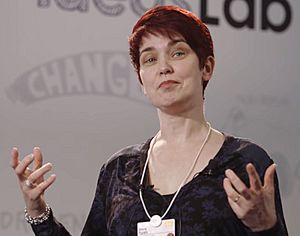Mary Ryan (materials scientist) facts for kids
Quick facts for kids
Mary Ryan
CBE FREng
|
|
|---|---|

Ryan speaks at the World Economic Forum in 2016
|
|
| Born |
Mary Patricia Ryan
|
| Alma mater | University of Manchester |
| Known for | Nanoscience Corrosion |
| Scientific career | |
| Institutions | Imperial College London Brookhaven National Laboratory |
| Doctoral students | Eleanor Schofield |
Mary Patricia Ryan is a brilliant scientist who studies materials. She is a Professor of Materials Science at Imperial College London in the UK. Materials science is all about understanding how different materials work, what they are made of, and how we can make them better or create new ones. Professor Ryan is also a Fellow of the Royal Academy of Engineering, which means she is recognized as one of the best engineers in the country.
Contents
Mary Ryan's Education
Mary Ryan studied at the University of Manchester for both her first degree and her advanced studies. For her PhD, which is a very high-level degree, she researched how very thin layers of rust (called "surface oxides") form on metals. She used special tools to study these layers as they were forming. She was the first person to show that these rust layers actually have a crystal structure, like tiny organized patterns.
After her studies in Manchester, she worked for three years at the Brookhaven National Laboratory in New York, USA. There, she developed new ways to study how chemicals react with materials using powerful X-rays from a machine called a synchrotron.
Her Work and Discoveries
Professor Ryan is an expert in electrochemistry, which is the study of how electricity and chemical reactions work together. She also specializes in how materials behave at their surfaces.
Joining Imperial College London
In 1998, Mary Ryan joined Imperial College London as a lecturer. Her research team explores several important areas:
- They investigate why materials rust or break down (this is called corrosion).
- They look for new materials that can protect other materials from damage.
- They also study materials that can manage heat, like those used in engines.
Studying Tiny Structures
Professor Ryan studies how metals are deposited using electricity and how stable different metals are. She also looks at how tiny structures of metals and oxides, called nanostructures, form. Nanostructures are incredibly small, often just a few atoms wide! She was a pioneer in using powerful X-rays to study these tiny structures as they react with chemicals, especially how stable they are.
In 2002, she wrote a very important paper in the famous science magazine Nature. This paper was titled "Why stainless steel corrodes," and it helped scientists understand more about how even strong materials like stainless steel can break down over time.
Helping Preserve History
In 2012, Professor Ryan helped advise on how to preserve a Dornier Do 17 airplane, which was a famous German aircraft from World War II. This plane, nicknamed 'The Flying Pencil,' was found underwater in Goodwin Sands. Her knowledge of materials helped figure out the best way to protect it.
She also took part in the World Economic Forum in 2016. There, she talked about how new materials, called nano-composite materials, could use the heat from a car engine to power the air conditioning. This could make cars more energy-efficient!
Nanomaterials and Conservation
More recently, her work has focused on how nanomaterials interact with living things. This includes studying if nanoparticles can be harmful and developing special materials that can detect tiny biological changes, which is useful for things like health sensing.
Professor Ryan also works with museums and heritage sites to develop new materials and ways to preserve old artifacts. She has worked with the Science Museum, the Royal Air Force Museum London, and the Victoria and Albert Museum. She often works with Dr. Eleanor Schofield, who helps take care of the collections at the Mary Rose Trust, which is a famous old ship.
Leadership Roles
In 2017, she became the Vice Dean of Research for the Faculty of Engineering at Imperial College London. This means she helps guide the research efforts for all the engineering departments. She also directs a special center that works with Shell, a big energy company, to study advanced materials. She is also a member of the London Centre for Nanotechnology, a leading research center for tiny materials.
Awards and Recognition
Mary Ryan has received many important awards for her work.
- In 2015, she was chosen as a Fellow of the Royal Academy of Engineering.
- She is also a Fellow of the Institute of Materials, Minerals and Mining.
- In 2022, she was given the title of Commander of the Order of the British Empire (CBE) by the King. This honor was for her great contributions to education and the science of materials and engineering.

